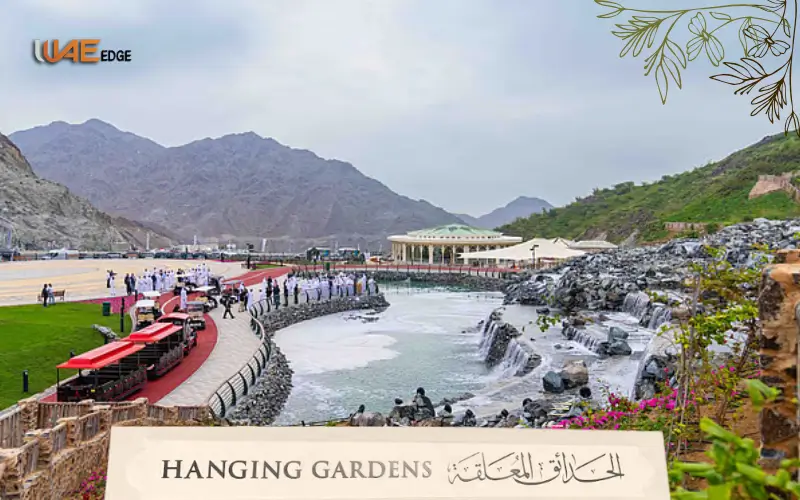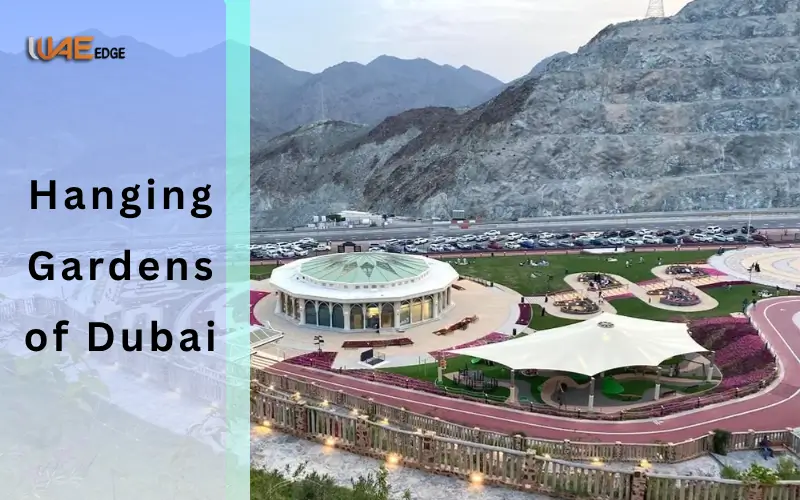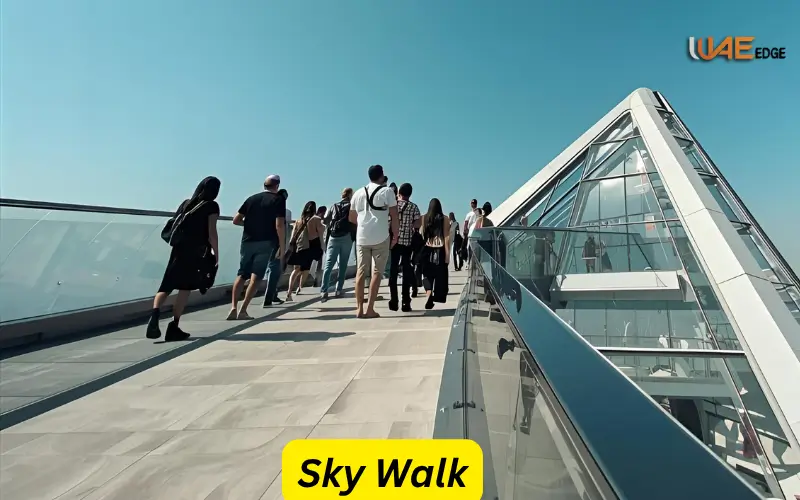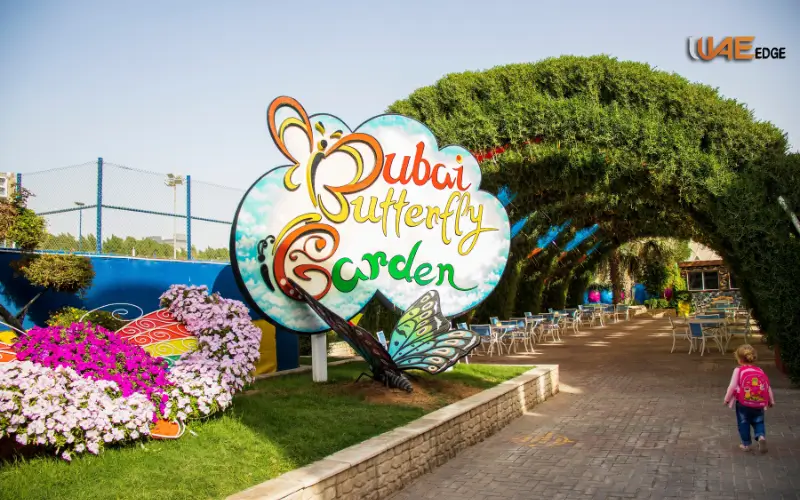Introduction
The Hanging Gardens of Dubai can be considered one of the most extraordinary modern attractions in the city, a marvelous combination of architecture, sustainability and nature. This marvel of the city is inspired by the Hanging Gardens of Babylon, one of the Seven Wonders of the Ancient World, and demonstrates that the city goes to extremes in terms of design and engineering.
The incorporation of vertical greenery, low terraces and complex irrigation systems makes the Hanging Gardens of Dubai the representation of the Emirate’s commitment to innovations and the desire to create a greener and sustainable environment in the city.
Visitor Information
Location and Accessibility
The Hanging Gardens of Dubai are located in a prime urban area — near Dubai Hills and Al Qudra Road, within easy reach of main highways and public transport.
| Detail | Information |
| Location | Near Dubai Hills, Al Qudra Road |
| Nearest Metro | Mall of the Emirates Station |
| Transport Options | Metro, taxi, RTA bus, or private car |
| Parking | Multi-level and valet available |
Opening Hours and Tickets
| Day | Timing |
| Monday–Sunday | 9:00 AM – 9:00 PM |
| Public Holidays | 9:00 AM – 10:00 PM |
Tickets:
Prices vary depending on access level:
- General Entry: AED 75 – 100
- VIP Access (Sky Deck): AED 180
- Family Package (2 Adults + 2 Kids): AED 250
Online pre-booking is recommended, especially during weekends.
Best Time to Visit
Gardens are full of life throughout the year though the best time to be there is between October and April when it has cooler temperatures, and the outside terraces would be the best.
History and Concept behind the Hanging Gardens of Dubai
Ancient World Inspirations
The idea behind the Hanging Gardens of Dubai was the Hanging Gardens of Babylon which were allegedly constructed in 600 BCE in Mesopotamia. Such ancient gardens were characterized by terraced gardens and a marvel of engineering wonder a green oasis on dry land.
Vision and Development
The project was seen as the contribution of the city of Dubai to sustainability and its Dubai 2040 Urban Master Plan which focuses on environmentally friendly architecture and green urban areas. The developers with the help of international architects and horticulturists and environmental engineers, created a space not only conventionally magnificent but also climate-considerate.
It was started at the end of the 2010s and completed in the early 2020s. The gardens were created to combine plants with the futuristic architecture, the use of local materials and drought-resistant plants that would be appropriate in the hot weather of Dubai.
Architecture and Design
Structural Concept
The Hanging Gardens of Dubai are arranged in the form of multi-tiered terraces and the levels include numerous plants, trees, and flower beds that can be seen falling like green waterfalls. The structure is a combination of steel and concrete and reinforced glass and not only enables transparency and light to enter, but it also enables light to exit.
The terraces are provided with built-in water channels and water features in such a way that plants are not overhydrated. This whole building has a smart water recycling system that gathers and recycles grey water used in adjacent structures.
Natural and Technological Hybridity
The Hanging Gardens in Dubai are based on superior hydroponic and aeroponic technologies – soil-free cultivation that conserves up to 70 percent more water compared to the conventional process. Solar-powered LED lighting improves the growth of plants at night, forming a beautiful illuminated offshore view.
Smart sensors monitor:
- Soil moisture levels
- Humidity
- Temperature
- Light intensity
These systems automatically regulate irrigation and lighting, and provide the best conditions for the plants.
Architectural Highlights
| Feature | Description |
| Design Style | Neo-futuristic with sustainable vertical greenery |
| Levels/Terraces | Multiple elevated layers with panoramic gardens |
| Materials Used | Reinforced glass, aluminum, concrete, natural stone |
| Technology | Hydroponics, automated irrigation, and solar energy |
| Lighting | LED eco-lights and bioluminescent-inspired designs |
| Viewpoints | Observation decks, sky bridges, and photo terraces |
Experience: What to See and Do
Entry and Layout
Once inside, there is a vibrant atrium that welcomes the visitor with cascading vines, tropical trees, and peaceful fountains. The density and misting system used to keep the air humid makes the air cooler.
As one walks up the terraces, every step brings a new ecosystem, desert plants, or rainforest-type foliage with native UAE plants and exotic ones all mixed.
Sky Walk and Observation Decks
The skywalk is one of the hottest spots where people can have a walk along a glass bridge between two towers of the gardens. It is a panoramic view of the skyline of Dubai, as well as the whole green landscape of the city below, that visitors can see here.
The observation decks provide 360-degree views and are particularly spectacular in the evening during the sunset, when the gardens are illuminated in hues of emerald, gold, and blue.
Themed Zones
The Hanging Gardens are separated into various themed areas, each of which is based on a specific ecological area:
Tropical Garden: It is a rainforest type of space with tall palms, orchids and misting falls.
Desert Bloom: The exhibition will feature plants of the UAE desert, including cacti, succulents, and date palms.
Zen Terrace: The Asian touch, bonsai trees, bamboo, and koi ponds.
Aromatic Valley: The place is full of aromatic herbs, such as lavender and rosemary, and jasmine.
Sky Flora: Showcases plants in high altitude, such as air plants, hanging ferns, etc.
Water features and lighting
The water flows down several vertical walls providing the effect of a waterfall, blending with vegetation. Light shows and music are synchronized after dark making the space a living artwork.
Dining and Relaxation Areas
There are a few cafes and fine-dining restaurants incorporated into the terraces that provide stunning views. There is a variety of dining choices between sustainable and organic menus and upscale rooftop lounges as well as local sourcing and sustainability.
Environmental Impact and Sustainability
Green Innovation
The Hanging Gardens of Dubai are not only beautiful but also a model of living in the city in terms of sustainability. The gardens help in cooling the microclimate in the area and minimizing the urban heat island effect.
Key Sustainability Features
| Feature | Environmental Benefit |
| Solar Energy Panels | Power lighting and irrigation systems |
| Greywater Recycling | Reduces water waste by reusing treated water |
| Native Plant Selection | Reduces water consumption |
| Vertical Shading | Lowers building temperature and saves energy |
| Air Purification | Improves city air quality |
Role in Dubai’s Green Vision
This attraction supports Dubai’s sustainability initiatives, such as:
- Dubai Clean Energy Strategy 2050
- Dubai Urban Master Plan 2040
- Green Building Regulations and Specifications
Through these projects, Dubai aims to become one of the world’s most sustainable cities.
Photography, Activities and Events
Seasonal Events
The Hanging Gardens also hold special events throughout the year including:
- Floral Festivals
- Art & Light Installations
- Sustainability Workshops
- Night Garden Shows
Photography and Filming
The place is the dream of a photographer in the world – each floor is a view of the picturesque background of plants, water, and the city landscape. It is a popular shooting location for many influencers, wedding photographers, and film crews (with their permission).
Nearby Attractions
Visitors can combine their trip with other nearby experiences:
| Attraction | Distance | Highlight |
| Dubai Miracle Garden | 15 min | World’s largest flower garden |
| Dubai Hills Mall | 10 min | Shopping and dining |
| Global Village | 20 min | Cultural theme park |
| Dubai Butterfly Garden | 15 min | Indoor tropical butterfly dome |
| Ain Dubai | 25 min | Observation wheel with sea view |
Future Prospect and Growth
The planners have already indicated their plans of expansion – maybe residential green sky tower and eco sky bridges between the adjacent districts. With the long-term perspective, it is the purpose to unify the Hanging Gardens concept into the urban areas of Dubai, to make rooftops and facades a part of the ecosystem.
Conclusion
The Hanging Gardens of Dubai is a living oasis to the love of innovation, art, and sustainability that Dubai has. To what was once just a myth, it has been made a reality, not using the masonry of old, but using the artistry and environmental insight of the here and now.
In a metropolis that is characterized by tall buildings and sand, the Hanging Gardens are a pleasant change of scenery, making it a heaven on earth, where technology and nature live side by side in harmony. It is not just a sightseeing spot, it is also an architectural site, a green lung of the city and it is a promise that the future of Dubai will be as green as it is magnificent.
Frequently asked questions about the Hanging Gardens of Dubai
Where are the Hanging Gardens of Dubai?
They are close to Dubai Hills and the Al Qudra Road, and they can be easily accessed by metro or by car.
What makes it unique?
It is an innovation of the old Hanging Gardens, with hanging plants and intelligent eco-systems.
How much is the ticket?
General admission costs are between AED 75 and 100, whereas VIP costs AED 180.
Is it family-friendly?
Yes, it is family-friendly, has baby-friendly trails and playgrounds.
What are the opening hours?
The gardens are closed on Sundays only.
Can I dine inside?
Yes, it has some cafes and restaurants with organic and tasty food.
When is the best time to visit?
It is best attended in the fall season between October and April, when the weather is nice and cool.
Related Blog: Sharjah Safari Park Where Africa Comes Alive in the UAE








